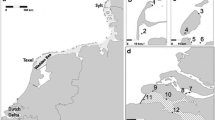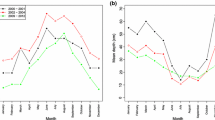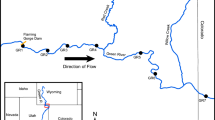Abstract
A dramatic increase in prevalence of the recently discovered bopyrid isopod parasite, Orthione griffenis, likely introduced in the 1980s from Asia to the Pacific coast of North America, coincided with the 2002 collapse of a population of its burrowing mud shrimp host, Upogebia pugettensis, in Willapa Bay, Washington that had been stable since monitoring began in 1988. An examination of whether O. griffenis infections were sufficient to cause this decline and other recently noted U. pugettensis population collapses in Pacific Coast estuaries was conducted. O. griffenis prevalence was the highest in large reproductive-sized female shrimp and caused an estimated average 68% loss of U. pugettensis reproduction in Yaquina Bay, Oregon over a 5-year period. O. griffenis prevalence fluctuated from year to year, but trends were similar in all estuaries sampled. Uninfected shrimp transplanted back into locations from which they had disappeared acquired the parasite, suggesting that O. griffenis is extremely effective at finding its host even in estuaries with very low host density. Since both U. pugettensis and O. griffenis have pelagic larval stages, their population dynamics are also influenced by coastal nearshore oceanography and estuarine recruitment success. Coastwide lack of estuarine recruitment appears to coincide with declines in density of a co-occurring thalassinid shrimp, Neotrypaea californiensis, but cannot alone explain U. pugettensis population collapses. Although patterns observed to date could be explained by the presence of either a native or introduced parasitic castrator, assumptions of a resilient co-evolved host–parasite relationship do not apply for introduced species, so continued efforts to follow the spatial extent and consequences of the O. griffenis–U. pugettensis host–parasite relationship are warranted.










Similar content being viewed by others
References
Anderson, G. 1977. The effects of parasitism on energy flow through laboratory shrimp populations. Marine Biology 42: 239–251.
Anderson, R.M., and R.M. May. 1978. Regulation and stability of host–parasite population interactions. 1. Regulatory processes. The Journal of Animal Ecology 47: 219–247.
Anderson, R.M., and R.M. May. 1979. Population biology of infectious diseases. 1. Nature 280: 361–367.
Andrews, J.D. 1980. A review of introductions of exotic oysters and biological planning for new importations. Marine Fisheries Review 42: 1–11.
Astete-Espinoza, L.P., and C.W. Caceres-Martinez. 2000. Efecto del parasitismo del isopodo boprido Ionella agassizi (Isopoda: Epicaridea) (Bornnier 1900) sobre la fisiologia nutricional del nape Neotrypaea uncinata (M. Edwards, 1837) (Decapoda: Thalassinidea). Revista chilena de historia natural 73: 243–252.
Bass, C.S., and J.S. Weis. 1999. Behavioral changes in the grass shrimp, Palaemonetes pugio (Holthuis), induced by the parasitic isopod, Probopyrus pandalicola (Packard). Journal of Experimental Marine Biology and Ecology 241: 223–233.
Bird, E. M. 1982. Population dynamics of thalassinidean shrimps and community effects through sediment modification. Ph.D. dissertation, University of Maryland, College Park, Maryland, p.150
Blower, S., and J. Roughgarden. 1987. Population-dynamics and parasitic castration—a mathematical-model. The American Naturalist 129: 730–754.
Blower, S., and J. Roughgarden. 1989. Population-dynamics and parasitic castration—test of a model. The American Naturalist 134: 848–858.
Boettner, G.H., J.S. Elkinton, and C.J. Boettner. 2000. Effects of a biological control introduction on three nontarget native species of saturniid moths. Conservation Biology 14: 1798–1806.
Boots, M., and A. Sasaki. 2003. Parasite evolution and extinctions. Ecological Letters 6: 176–182.
Burnham, K.P., and D.E. Anderson. 2002. Model selection and multimodel inference: A practical information-theoretic approach, 2nd ed. New York: Springer.
Calado, R., C. Bartilotti, and L. Narciso. 2005. Short report on the effect of a parasitic isopod on the reproductive performance of a shrimp. Journal of Experimental Marine Biology and Ecology 321: 13–18.
Carlton, J.T., and J.B. Geller. 1993. Ecological roulette: The global transport of nonindigenous marine organisms. Science 261: 78–82.
Choi, J.H., G. Jamieson, K.H. Han, and S.Y. Hong. 2004. Parapenaeon consolidatum (Isopoda: Bopyridae) and the relative growth and reproduction of Metapenaeopsis dalei (Decapoda: Penaeidae) in South Korea. Journal of Shellfish Research 23: 237–242.
Crofton, H.D. 1971. Model of host–parasite relationships. Parasitology 63: 343–364.
D'Andrea, A.F., and T.H. DeWitt. 2009. Geochemical ecosystem engineering by the mud shrimp Upogebia pugettensis (Crustacea: Thalassinidae) in Yaquina Bay, Oregon: Density-dependent effects on organic matter remineralization and nutrient cycling. Limnology and Oceanography 54: 1911–1932.
de Castro, F., and B. Bolker. 2005. Mechanisms of disease-induced extinction. Ecological Letters 8: 117–126.
Deredec, A., and F. Courchamp. 2003. Extinction thresholds in host–parasite dynamics. Annales Zoologici Fennici 40: 115–130.
Dewitt, T. H., A. F. D'Andrea, C. A. Brown, B. D. Griffen, and P. M. Eldridge. 2004. Impact of burrowing shrimp populations on nitrogen cycling and water quality in western North American temperate estuaries. In Proceedings of the symposium on “Ecology of large bioturbators in tidal flats and shallow sublittoral sediments-from individual behavior to their role as ecosystem engineers”, 107–118. Nagasaki, Japan: Nagasaki University.
Dobson, A.P., and P.J. Hudson. 1992. Regulation and stability of a free-living host–parasite system—Trichostrongylus-tenuis in red grouse. 2. Population-models. The Journal of Animal Ecology 61: 487–498.
Dobson, A., K.D. Lafferty, A.M. Kuris, R.F. Hechinger, and W. Jetz. 2008. Homage to Linnaeus: How many parasites? How many hosts? Proceedings of the National Academy of Sciences of the United States of America 105: 11482–11489.
Dumbauld, B.R., D.A. Armstrong, and K.L. Feldman. 1996. Life-history characteristics of two sympatric thalassinidean shrimps, Neotrypaea californiensis and Upogebia pugettensis, with implications for oyster culture. Journal of Crustacean Biology 16: 689–708.
Dumbauld, B.R., K.M. Brooks, and M.H. Posey. 2001. Response of an estuarine benthic community to application of the pesticide carbaryl and cultivation of Pacific oysters (Crassostrea gigas) in Willapa Bay, Washington. Marine Pollution Bulletin 42: 826–844.
Dumbauld, B.R., K. Feldman, and D. Armstrong. 2004. A comparison of the ecology and effects of two species of thalassinidean shrimps on oyster aquaculture operations in the eastern North Pacific. In Proceedings of the symposium on “Ecology of large bioturbators in tidal flats and shallow sublittoral sediments-from individual behavior to their role as ecosystem engineers”, ed. A. Tamaki, 53–61. Nagasaki: Nagasaki University.
Edgerton, B.F., P. Henttonen, J. Jussila, A. Mannonen, P. Paasonen, T. Taughol, I. Edsman, and Souty-Grosset. 2004. Understanding the causes of disease in freshwater crayfish. Conservation Biology 18: 1466–1474.
Feldman, K. 2001. Contrasting patterns of habitat-specific recruitment success in sympatric species of thalassinidean shrimp: Effects of epibenthic bivalve shell with implications for population control in areas with commercial oyster aquaculture. Ph.D. dissertation, University of Washington, Seattle, Washington, p.194
Fenton, A., J.P. Fairbairn, R. Norman, and P.J. Hudson. 2002. Parasite transmission: Reconciling theory and reality. The Journal of Animal Ecology 71: 893–905.
Ferraro, S.P., and F.A. Cole. 2004. Optimal benthic macrofaunal sampling protocol for detecting differences among four habitats in Willapa Bay, Washington, USA. Estuaries 27: 1014–1025.
Griffen, B.D. 2009. Effects of a newly invasive parasite on the burrowing mud shrimp, a widespread ecosystem engineer. Marine Ecology Progress Series 391: 73–83.
Griffen, B.D., T.H. DeWitt, and C. Langdon. 2004. Particle removal rates by the mud shrimp Upogebia pugettensis, its burrow, and a commensal clam: effects on estuarine phytoplankton abundance. Marine Ecology Progress Series 269: 223–236.
Gurevitch, J., and D.K. Padilla. 2004. Are invasive species a major cause of extinctions? Trends in Ecology & Evolution 19: 470–474.
Hart, J.F.L. 1937. Larval and adult stages of British Columbia Anomura. Canadian Journal of Research 15: 179–219.
Hokkanen, H.M.T., and D. Pimentel. 1989. New associations in biological-control—theory and practice. The Canadian Entomologist 121: 829–840.
Hornig, S., S.D. Smith, and A. Sterling. 1989. Species Profiles: Life histories and environmental requirements of coastal fishes and invertebrates (Pacific Northwest): Ghost shrimp and blue mud shrimp. Biological Report, 1–14. Washington, D.C.: Fish and Wildlife Service.
Hudson, P.J., A.P. Dobson, and D. Newborn. 1998. Prevention of population cycles by parasite removal. Science 282: 2256–2258.
Hudson, P.J., M. Cattadori, B. Boag, and A.P. Dobson. 2006. Climate disruption and parasite–host dynamics: Patterns and processes associated with warming and the frequency of extreme climatic events. Journal of Helminthology 80: 175–182.
Huey, R.B., G.W. Gilchrest, and A.P. Hendry. 2005. Using invasive species to study evolution: case studies with Drosophila and salmon. In Species invasions: Insights into ecology, evolution, and biogeography, ed. D.F. Sax, J.J. Stachowicz, and S.D. Gaines, 139–164. Sunderland: Sinauer Associates.
Hutchings, J.A. 2000. Collapse and recovery of marine fishes. Nature 406: 882–885.
Keane, R.M., and M.J. Crawley. 2002. Exotic plant invasions and the enemy release hypothesis. Trends in Ecology & Evolution 17: 164–170.
Kermack, W.O., and A.G. McKendrick. 1927. Contributions to the mathematical theory of epidemics. 1. Proceedings of the Royal Society B-Biological Sciences 263: 75–81.
Keymer, A. 1981. Population-dynamics of Hymenolepis-diminuta in the intermediate host. The Journal of Animal Ecology 50: 941–950.
Kuris, A.M. 1974. Trophic interactions: Similarity of parasitic castrators to parasitoids. The Quarterly Review of Biology 49: 129–148.
Kuris, A.M. 2003. Did biological control cause extinction of the coconut moth, Levuana iridescens, in Fiji? Biological Invasions 5: 133–141.
Kuris, A.M., and K.D. Lafferty. 1992. Modeling crustacean fisheries—effects of parasites on management strategies. Canadian Journal of Fisheries and Aquatic Sciences 49: 327–336.
Kuris, A.M., R.F. Hechinger, J.C. Shaw, K.L. Whitney, L. Aguirre-Macedo, C.A. Boch, A.P. Dobson, E.J. Dunham, B.L. Fredensborg, T.C. Huspeni, J. Lorda, L. Mababa, F.T. Mancini, A.B. Mora, M. Pickering, N.L. Talhouk, M.E. Torchin, and K.D. Lafferty. 2008. Ecosystem energetic implications of parasite and free-living biomass in three estuaries. Nature 454: 515–518.
Lafferty, K.D. 1993. Effects of parasitic castration on growth, reproduction and population-dynamics of the marine snail Cerithidea californica. Marine Ecology Progress Series 96: 229–237.
Lafferty, K.D., and L.R. Gerber. 2002. Good medicine for conservation biology: The intersection of epidemiology and conservation theory. Conservation Biology 16: 593–604.
Lafferty, K.D., and A.M. Kuris. 2002. Trophic strategies, animal diversity and body size. Trends in Ecology & Evolution 17: 507–513.
Leija-Tristan, A., and S.I. Salazar-Vallejo. 1991. Parasitismo de Progebiophilus bruscai (Isopoda: Bopyridae) sobre el camaron Upogebia dawsoni (Thalassinoidea: Upogebiidae), en Baja California Sur, Mexico. Revista de Biología Tropical 39: 1–5.
MacGinitie, G.E. 1935. Ecological aspects of a California marine estuary. American Midland Naturalist 16: 629–765.
Markham, J.C. 1977. The status and systematic position of the bopyrid isopod genus Phyllodurus Stimpson, 1857. Proceedings. Biological Society of Washington 90: 813–819.
Markham, J.C. 1986. Evolution and zoogeography of Isopoda Bopyridae, parasites of Crustacea Decapoda. Crustacean Research 4: 143–164.
Markham, J.C. 2001. A review of the bopyrid isopods parasitic on thalassinidean decapods. In Crustacean issues: Isopod systematics and evolution, ed. B. Kensley and R.C. Brusca, 195–204. Amsterdam: Balkema.
Markham, J.C., and P.C. Dworschak. 2005. A new species of Entophilus Richardson, 1903 (Isopoda: Bopyridae: Entophilinae) from the Gulf of Aqaba, Jordan. Journal of Crustacean Biology 25: 413–419.
Marrin Jarrin, J.R., and A.L. Shanks. 2008. Ecology of a population of Lissocrangon stylirostris (Caridea: Crangonidae), with notes on the occurrence and biology of Its parasite, Argeia pugettensis (Isopoda: Bopyridae). Journal of Crustacean Biology 28: 613–621.
May, R.M., and R.M. Anderson. 1979. Population biology of infectious-diseases. 2. Nature 280: 455–461.
McCallum, H.I., A. Kuris, C.D. Harvell, K.D. Lafferty, G.W. Smith, and J. Porter. 2004. Does terrestrial epidemiology apply to marine systems? Trends in Ecology & Evolution 19: 585–591.
Mitchell, C.E., and A.G. Power. 2003. Release of invasive plants from fungal and viral pathogens. Nature 421: 625–627.
Munoz, G., and M. George-Nascimento. 1999. Efectos reproductivos reciprocos en la simbiosis entre napes (Decapods: Thalassinidea) e isopodos bopiridos (Isopoda: Epicaridea) en Lenga, Chile. Revista Chilena de Historia Natural 72: 49–56.
NMFS. 1999. Our living oceans. Report on the status of U.S. living marine resources, 1999. U.S. Dep. Commer., NOAA Tech. Memo. NMFS-F/SPO-41.
O'Brien, J.J., and P. Van Wyk. 1985. Effects of crustacean parasitic castrators (epicaridean isopods and rhizocephalan barnacles) on growth of crustacean hosts. In Crustacean issues: Factors in adult growth, ed. A.M. Wenner, 191–218. Rotterdam: Balkema.
O'Keefe, K.J., and J. Antonovics. 2002. Playing by different rules: The evolution of virulence in sterilizing pathogens. The American Naturalist 159: 597–605.
Perez, C. 1923. The castration of crustacean decapods parasited by Epicaridea. Comptes Rendus Hebdomadaires Des Seances De L Academie Des Sciences 176: 1934–1936.
Posey, M.H. 1986. Changes in a benthic community associated with dense beds of a burrowing deposit feeder, Callianassa californiensis. Marine Ecology Progress Series 31: 15–22.
R Development Core Team. 2008. R: A language and environment for statistical computing. R foundation for statistical computing, Vienna, Austria. http://www.R-project.org
Sax, D.F., J.J. Stachowicz, J.H. Brown, J.F. Bruno, M.N. Dawson, S.D. Gaines, R.K. Grosberg, A. Hastings, R.D. Holt, M.M. Mayfield, M.I. O'Connor, and W.R. Rice. 2007. Ecological and evolutionary insights from species invasions. Trends in Ecology & Evolution 22: 465–471.
Scott, M.E. 1987. Regulation of mouse colony abundance by Heligmosomoides polygyrus (Nematoda). Parasitology 95: 111–129.
Scott, M.E., and R.M. Anderson. 1984. The population-dynamics of Gyrodactylus-bullatarudis (Monogenea) within laboratory populations of the fish host Poecilia-reticulata. Parasitology 89: 159–194.
Shanks, A.L., and G.C. Roegner. 2007. Recruitment limitation in Dungeness crab populations is driven by variation in atmospheric forcing. Ecology 88: 1726–1737.
Shea, K., and P. Chesson. 2002. Community ecology theory as a framework for biological invasions. Trends in Ecology & Evolution 17: 170–176.
Smith, K.F., D.F. Sax, and K.D. Lafferty. 2006. Evidence for the role of infectious disease in species extinction and endangerment. Conservation Biology 20: 1349–1357.
Smith, A.E., J.W. Chapman, and B.R. Dumbauld. 2008. Population structure and energetics of the bopyrid isopod parasite Orthione griffenis in mud shrimp Upogebia pugettensis. Journal of Crustacean Biology 28: 228–233.
Stiven, A.E. 1964. Experimental studies on the host parasite system Hydra and Hydramoeba hydroxena (Entz.). II. The components of a single epidemic. Ecological Monographs 34: 119–142.
Swinbanks, D.D., and J.L. Luternauer. 1987. Burrow distribution of thalassinidean shrimp on a Fraser delta tidal flat, British Columbia. Journal of Paleontology 613: 315–332.
Taylor, C.M., and A. Hastings. 2005. Allee effects in biological invasions. Ecological Letters 8: 895–908.
Torchin, M.E., K.D. Lafferty, and A.M. Kuris. 2001. Release from parasites as natural enemies: Increased performance of a globally introduced marine crab. Biological Invasions 3: 333–345.
Torchin, M.E., K.D. Lafferty, A.P. Dobson, V.J. McKenzie, and A.M. Kuris. 2003. Introduced species and their missing parasites. Nature 421: 628–630.
Tucker, B.W. 1930. On the effects of an epicaridean parasite, Gyge branchialis, on Upogebia littoralis. The Quarterly Journal of Microscopical Science 74: 1–118.
Van Engel, W.A., W.A. Dillon, D. Zwerner, and D. Eldridge. 1965. Loxothylacus panopaei (Cirripedia, Sacculinidae) an introduced parasite on the xanthid crab in Chesapeake Bay, U.S.A. Crustaceana 10: 111–112.
Vermeij, G.J. 1996. An agenda for invasion biology. Biological Conservation 78: 3–9.
Walker, S.P. 1977. Probopyrus pandalicola: Discontinuous ingestion of shrimp hemolymph. Experimental Parasitology 41: 198–205.
Warner, R.E. 1969. The role of introduced diseases in the extinction of the endemic Hawaiian avifauna. Condor 70: 101–120.
Wilcove, D.S., D. Rothstein, J. Dubow, A. Phillips, and E. Losos. 1998. Quantifying threats to imperiled species in the United States. Bioscience 48: 607–615.
Williams, M.R. 1996. Species-area curves: The need to include zeroes. Global Ecology and Biogeography Letters 5: 91–93.
Williams, J.D., and J.M. An. 2009. The cryptogenic parasitic isopod Orthione griffenis Markham, 2004 from the eastern and western Pacific. Integrative and Comparative Biology 49: 114–126.
Windsor, D.A. 1998. Most of the species on earth are parasites. International Journal for Parasitology 28: 1939–1941.
Woods, L., J.W. Chapman, and B.R. Dumbauld. 2006. The effects of a blood-sucking parasite from castration to feminization. REU Summer Reports, 1–11. Newport: Oregon State University, Hatfield Marine Science Center.
Acknowledgments
This research was funded in part by the US Department of Agriculture, Agricultural Research Service, the Washington State Legislature via a grant to JWC to examine biological control of shrimp, a grant to AMK from the USFWS through the Coastal Resources Alliance, funding from NSF for the REU program at Hatfield Marine Science Center, and in-kind field assistance from the LCCSC-OYCC field crews. Historical monitoring was funded by the Washington Department of Fish and Wildlife and several grants to David Armstrong and BRD from the Western Regional Aquaculture Center. We especially thank Lee McCoy and Cara Fritz for their help in the field and with data analysis. Katelyn Cassidy, Roy Hildenbrand, Roxanna Hintzman, Kristine Feldman, Bruce Kauffman, Michael Herrle, Andy Smith, Lauren Woods, Caitlin White, Xeronimo Castaneda, Erin Ashley, Sara Heerhartz, and numerous others assisted with shrimp sampling. Finally, we thank Melanie Frazier, Vladlina Gerteseva, and two anonymous reviewers for their comments on the manuscript.
Author information
Authors and Affiliations
Corresponding author
Electronic supplementary material
Below is the link to the electronic supplementary material.
ESM 1
(DOC 26174 kb)
Rights and permissions
About this article
Cite this article
Dumbauld, B.R., Chapman, J.W., Torchin, M.E. et al. Is the Collapse of Mud Shrimp (Upogebia pugettensis) Populations Along the Pacific Coast of North America Caused by Outbreaks of a Previously Unknown Bopyrid Isopod Parasite (Orthione griffenis)?. Estuaries and Coasts 34, 336–350 (2011). https://doi.org/10.1007/s12237-010-9316-z
Received:
Revised:
Accepted:
Published:
Issue Date:
DOI: https://doi.org/10.1007/s12237-010-9316-z




